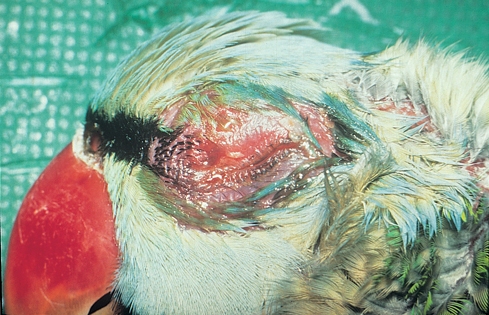Difference between revisions of "Avian Medicine Q&A 24"
Jump to navigation
Jump to search
(Created page with "<br style="clear:both;" /> {| align="left" width="100%" style="background-color:#04B4AE" |- | align="center" | 90px|Mansonlogo | align="left" | This ques...") |
|||
| (2 intermediate revisions by 2 users not shown) | |||
| Line 3: | Line 3: | ||
|- | |- | ||
| align="center" | [[File:Manson_logo.gif|90px|Mansonlogo]] | | align="center" | [[File:Manson_logo.gif|90px|Mansonlogo]] | ||
| − | | align="left" | This question was provided by [[:Category:Manson|Manson Publishing]] as part of the [[OVAL Project]]. See more [[ | + | | align="left" | This question was provided by [[:Category:Manson|Manson Publishing]] as part of the [[OVAL Project]]. See more [[Category: Avian Medicine Q&A|Avian Medicine questions]] |
|} | |} | ||
<br><br><br> | <br><br><br> | ||
| Line 13: | Line 13: | ||
|q1= What is your primary differential diagnosis? | |q1= What is your primary differential diagnosis? | ||
|a1= Poxvirus infection of the conjunctiva and periorbital skin. | |a1= Poxvirus infection of the conjunctiva and periorbital skin. | ||
| − | |l1= | + | |l1= Poxvirus Skin Infections |
|q2= List several possible differential diagnoses. | |q2= List several possible differential diagnoses. | ||
|a2= In psittacines, circovirus – PBFD – must also be considered as a similar lesion can be seen. | |a2= In psittacines, circovirus – PBFD – must also be considered as a similar lesion can be seen. | ||
In all birds, other infectious diseases, hypersensitivity, and trauma should be ruled out. | In all birds, other infectious diseases, hypersensitivity, and trauma should be ruled out. | ||
| − | |l2= | + | |l2= Poxvirus Skin Infections |
|q3= What is necessary to make a definitive diagnosis? | |q3= What is necessary to make a definitive diagnosis? | ||
|a3= A definitive diagnosis is made histologically by observing the characteristic intracytoplasmic inclusion bodies in epithelial cells. | |a3= A definitive diagnosis is made histologically by observing the characteristic intracytoplasmic inclusion bodies in epithelial cells. | ||
| − | |l3= | + | |l3= Poxvirus Skin Infections |
|q4= How is the disease transmitted? | |q4= How is the disease transmitted? | ||
|a4= The disease can spread by direct contact and by biting insects; control of the latter may be necessary to stop an outbreak. | |a4= The disease can spread by direct contact and by biting insects; control of the latter may be necessary to stop an outbreak. | ||
| − | |l4= | + | |l4= Poxvirus Skin Infections |
</FlashCard> | </FlashCard> | ||
Revision as of 15:36, 29 June 2011
| This question was provided by Manson Publishing as part of the OVAL Project. See more |
Shown above is the presenting lesion in a bird from a group with several affected individuals.
| Question | Answer | Article | |
| What is your primary differential diagnosis? | Poxvirus infection of the conjunctiva and periorbital skin.
|
Link to Article | |
| List several possible differential diagnoses. | In psittacines, circovirus – PBFD – must also be considered as a similar lesion can be seen.
In all birds, other infectious diseases, hypersensitivity, and trauma should be ruled out. |
Link to Article | |
| What is necessary to make a definitive diagnosis? | A definitive diagnosis is made histologically by observing the characteristic intracytoplasmic inclusion bodies in epithelial cells.
|
Link to Article | |
| How is the disease transmitted? | The disease can spread by direct contact and by biting insects; control of the latter may be necessary to stop an outbreak.
|
Link to Article | |
